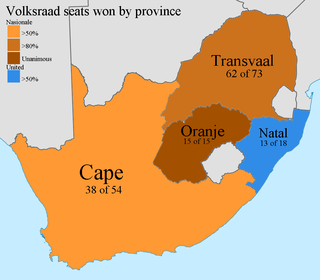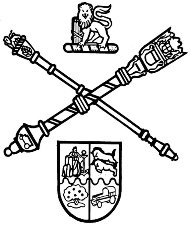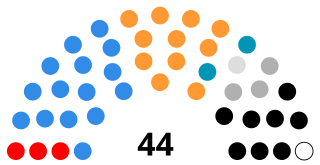1910–1981
Senate of South Africa Senaat van Suid-Afrika | |
|---|---|
 | |
| Type | |
| Type | |
| History | |
| Established | 1910 |
| Disbanded | 1981 |
| Succeeded by | President's Council |
| Leadership | |
| Elections | |
| Indirectly elected by members of the House of Assembly and Provincial Councils and appointed by the State President on the advice of the Prime Minister | |
Last election | 30 May 1974 |
| Meeting place | |
| Houses of Parliament Cape Town, Cape Province South Africa | |
Under white minority rule in the Union of South Africa, most of the Senators were chosen by an electoral college consisting of members of each of the four provincial councils and Members of the House of Assembly (the lower house of Parliament, directly elected). The remaining Senators were appointed by the Governor-General of the Union on the advice of the Prime Minister. The Senate's presiding officer was called the President, whereas his counterpart in the House of Assembly was the Speaker.
First Senate (1910–1920)
The South Africa Act 1909, which created the Senate, included special provisions for the selection of the first elected senators. The Union Parliament was prohibited from changing the arrangements for the Senate during its first ten years.
The First Senate included eight senators from each province. They were elected for a ten-year term, by the members serving during the final session of the legislatures of each of the four colonies which joined the Union of South Africa. The election was by a form of the single transferable vote. The remaining eight seats were filled, by appointment (also for ten-year terms) by the Governor-General-in-Council (in effect by General Louis Botha's first Union government). Section 24 of the South Africa Act 1909 provided that, of the nominated Senators,
One-half of their number shall be selected on the ground mainly of their thorough acquaintance, by reason of their official experience or otherwise, with the reasonable wants and wishes of the coloured races in South Africa.
Casual vacancies in the representation of the provinces, in the First Senate only, were filled by an electoral college composed of the members of the relevant Provincial Council. New senators, elected in this way, held the seat for the residue of the ten-year term. Nominated senators, appointed to fill vacancies, received a ten-year term and did not have to vacate their seats at the end of the term for the provincial representatives.
The composition, by party, of the provincial representatives in the First Senate included 18 representatives of the three colonial governing parties (six each from the South African Party of the Cape, Orangia Unie of the Orange River Colony and Het Volk of the Transvaal), eight Independent Senators from Natal (which did not have a party system before the Union), and six Senators from the opposition parties (two each from the Unionist Party of the Cape, the Constitutional Party of Orange River Colony and the Progressive Party of Transvaal). [1]
Second Senate (1920–1929)
The eight senators, elected for each province under the ordinary provisions for senate elections in the South Africa Act 1909, were returned by an electoral college composed of the members from the province in the House of Assembly and the Provincial Council. In 1920 the Senate term was for ten years and there was no provision for an earlier dissolution of the Senate.
The provisions for nominated senators were unchanged from those in the First Senate.
The Second Senate had a small majority for the South African Party (SAP). When the National Party (NP)-led Pact government took office in 1924, its supporters were therefore in a minority in the Senate.
The Senate Act 1926 modified the original constitutional provisions for the Senate. A new power was conferred so that the Governor-General-in-Council could dissolve the whole Senate (vacating both elected and nominated seats), either at the time of a general election for the House of Assembly or within 120 days of the election. Another provision required the nominated Senators to vacate their seats whenever there was a change of government.
After the South African general election, 1929 the Senate dissolution power was used for the first time, on 16 August 1929. [2]
Third Senate (1929–1939)
The Third Senate had a small NP majority, in 1929. After the NP and the SAP formed a coalition in 1933 and fused to form the United Party (UP) in 1934, the government had a large Senate majority.
The UP government passed the Representation of Natives Act 1936. This legislation affected the Senate by adding another four Senators to represent the black population of South Africa. The Native Representative Senators were white people, who held office for a fixed term and were not affected by a dissolution of the Senate. The new seats were filled by indirect election, the black electors being officeholders such as tribal chiefs and the members of local government bodies.
Just before the expiry of the ten-year Senate term, the UP split over the issue of South Africa's participation in the Second World War. The followers of the former Prime Minister J. B. M. Hertzog entered the 1939 Senate election as a separate party, having left the United Party but not yet arranged a merger with the opposition Purified National Party. [3]
Fourth Senate (1939–1948)
The provincial electoral colleges met on 17 November 1939. After the election and the filling of the nominated seats, the Senate was left with a pro-war majority. There were 24 pro-government Senators (20 UP including seven nominated members, two Dominion Party and two Labour Party) and 16 opposition Senators (10 supporters of General Hertzog including one nominated member, and 6 Purified National Party). The four Native Representative Senators were also pro-war. [4]
After the South African general election, 1948 a Reunited National Party-Afrikaner Party coalition came to power, with minority support in the Senate. The new government used the dissolution power, to trigger a new Senate election. The Senate was dissolved, on 9 July 1948. [5]
Fifth Senate (1948–1955)
The eight nominated Senators were appointed on 28 July 1948 and the Electoral Colleges met in the provincial capitals the following day. At the end of this process the government had 22 supporters (Reunited National Party 11, Afrikaner Party 2, Independent 1 and the 8 nominated Senators) and the opposition 21 (United Party 15, Labour Party 3, and Native Representatives 3). The fourth Native Representative seat was vacant. [6]
The South West Africa Affairs Amendment Act 1949, added four additional members to the Senate, of whom two were to be elected, and two nominated by the Governor-General. [7] The elected senators were chosen by an Electoral College, composed of the members of South West Africa's Legislative Assembly and the six members of the House of Assembly representing the territory. [8]
Of the nominated senators, one was to be selected mainly on the ground of his "thorough acquaintance, by reason of his official experience or otherwise, with the reasonable wants and wishes or the coloured races of the territory". [9] All four Senators chosen on 29 September 1950 were NP supporters. [10]
Senate Act 1955 (Senate 1955–1960)
In 1955, Nationalist Prime Minister Johannes Strijdom attempted to amend one of the entrenched clauses in the Constitution, to deprive Coloured people of their voting rights, but his party did not have the constitutionally required two-thirds majority in a joint session of both houses of Parliament. It was decided to alter the composition and electoral system for the Senate, to enable the Separate Representation of Voters Act 1951 to be validated. Consequently, Strijdom had the Senate Act 1955 passed to amend the constitution.
Instead of each province electing eight Senators, by proportional representation, the new system required provincial representatives to be selected by a first past the post election in the Electoral College. The effect of this was to enable the majority group from each province (NP in all the provinces, except for Natal) to secure all the seats available. In addition Cape Province and Transvaal had their representation increased to 22 and 27 seats respectively. The number of nominated Senators from the Union of South Africa was doubled from eight to sixteen. The representation of South-West Africa and black voters was unchanged.
Another change made in 1955 was to reduce Senatorial terms from ten years to five. The size of the Senate rose from 48 to 89 (increased to 90 in 1956 when a nominated Senator was added to represent the coloured population for a fixed term until 1962). [11]
Senate Act 1960 (Senate 1960–1980)
At the end of the last term of the Native Representative Senators, in 1960, those seats were abolished. The Senate Act 1960 reduced the size of the Senate and reinstated proportional representation elections. However instead of going back to eight Senators per province, the Cape would have 11, Transvaal 14 (15 from 1970) and the two smaller provinces would retain 8 Senators. Again, the representation from South-West Africa was unchanged. The number of nominated Senators from the Union, went back to eight and the requirement for half of them to be acquainted with the 'reasonable wants and wishes' of non-white South Africans was abolished.
The Senate was reduced in size to 54 in 1960 and 53 in 1962 (as the representative of the coloured community retained his seat until 1962). [12]
The Senate composition remained unchanged by the declaration of the Republic of South Africa in 1961, except that the State President took over the role of the Governor-General in appointing Senators. Under the republican Constitution, the President of the Senate was to act as State President whenever that office was vacant, or if a state president was unable to perform his duties.
Section 28 (1) (a) of the Republic of South Africa Constitution Act 1961, provided that there should be "eight senators nominated by the State President of whom two shall be nominated from each province ...". The South Africa Act 1909 had not limited the number of nominated senators to be from any particular province.
South-West Africa's representation in the South African Parliament was abolished in 1977, to pave the way for independence for the territory. [13]













